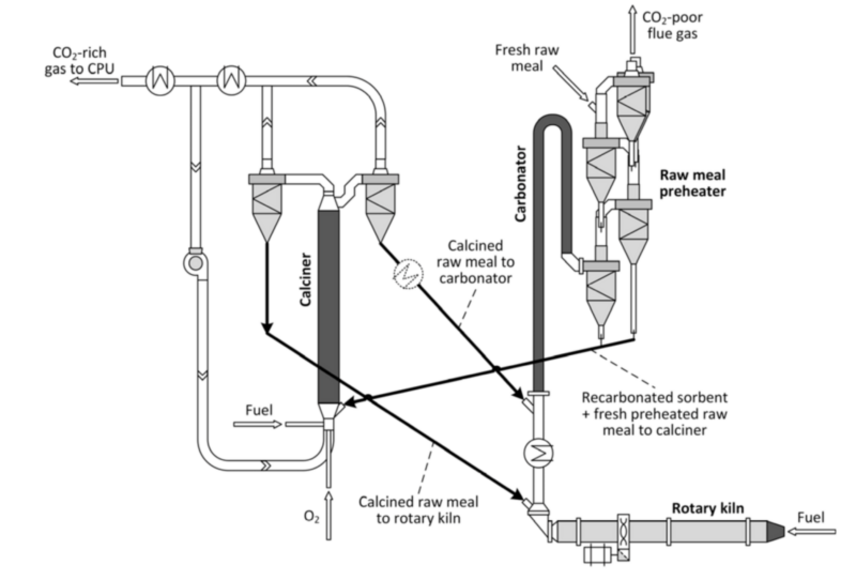A promising method of CO2 capture from cement works exhaust gases is process integration of a calcium looping process, which up until now has only been viewed as a system for the downstream capture of CO2 from the exhaust gas. This technology is considered to offer potential for the cement industry in particular, as CaO is used as sorbent for CO2. The resultant CaCO3 can be directly utilised as a raw material component.
CLEANKER – Integrated calcium looping process for CO₂ capture
The aim of the CLEANKER (CLEAN clinKER) project is to perform large-scale testing of this technology as an integrated method (Technology Readiness Level 7). It is planned to treat 4 000 m³/h exhaust gas in a demonstration plant to be connected to an existing kiln line at the Buzzi Unicem works in Vernasca in Italy.
Background and goals of the research project

In detail, the concept involves the use of a so-called carbonator, which is intended to capture CO2 from the kiln exhaust gas through the carbonation of CaO, and an Oxyfuel-driven calciner to generate the purest possible flow of CO2. The CaO/CaCO3 is then exchanged between these units and/or partly circulated. Once it has been cooled for heat recovery, the CO2-enriched exhaust gas flow is transferred to a processing installation. Thus it's possible to capture the CO2 emissions arising from both the fuel and the material.
![[Translate to English:] Demonstrationsanlage im Zementwerk (Quelle: IKN)](/fileadmin/_processed_/a/8/csm_csm_Abbildung-Cleanker-akt_40089dcb62_6b0a155c78.png)
The aim of the CLEANKER (CLEAN clinKER) project is to perform large-scale testing of this technology as an integrated method (Technology Readiness Level 7). It is planned to treat 4 000 m3/h exhaust gas in a demonstration plant to be connected to an existing kiln line at the Buzzi Unicem works in Vernasca in Italy. In the course of the test campaign, various raw materials are also to be studied with regard to their suitability for use as CO2 sorbents. The intention is thus to check the feasibility of the integrated calcium looping concept and the maintenance of constant product quality. VDZ is providing measurement technology, analytical services and cement expertise to support the project. Following demonstration of the technology, a technical and economic study will be performed for existing cement works based on scaling-up of the results and modelling of this process.
Use will also be made for this purpose of the process technology model developed by VDZ, which will be expanded for the specific application by incorporating the experimental results obtained. The following ambitious targets have been set for integration of the method into the clinker burning process:
- CO2 capture > 90 %
- Increase in electrical energy demand < 20 %
- Specific primary fuel requirement for CO2 capture (SPECCA) < 2 MJLHV/kgCO2
- Costs of CO2 capture < 30 €/tCO2
- Increase in cement production costs < 25 €/tcement
Above and beyond the demonstration of CO2 capture, the project is also intended to test CO2 storage by means of the mineralisation of waste materials. The project is currently in the design and development phase.
Project partners
- LEAP (Project management) (Italy)
- Buzzi Unicem (Italy)
- CSIC (Spain)
- Italcementi-HeidelbergCement Group (Italy)
- IKN (Germany)
- Lappeenranta University of Technology (Finland)
- Politecnico di Milano (Italy)
- Quantis (Switzerland)
- Tallinn University of Technology (Estonia)
- Tsinghua University (China)
- University of Stuttgart
- ADT (Italy)
Sponsors

This project is funded by the Horizon 2020 research and innovation program of the European Union under grant agreement no. 764816.
